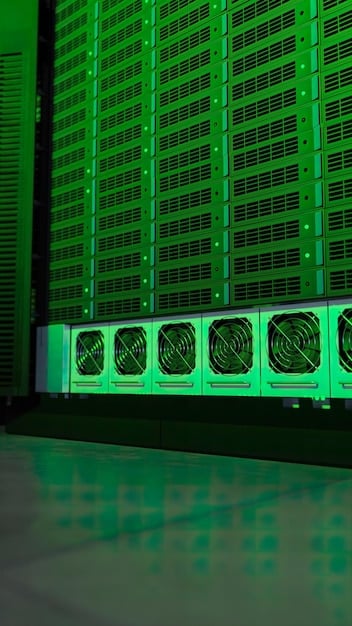Energy Storage System Cybersecurity: Protecting US Investments

Energy Storage System (ESS) cybersecurity is crucial for protecting investments in the US energy sector from evolving cyber threats, ensuring grid stability and data security.
Energy Storage Systems (ESS) are becoming increasingly vital to the US energy infrastructure. Protecting your investment through robust energy storage system cybersecurity measures is not just smart; it’s essential in today’s digital landscape.
Energy storage system cybersecurity: understanding the landscape
The energy sector is a constant target for cyberattacks, with Energy Storage Systems now a key potential vulnerability. Understanding the threat landscape is the first step in defending your investment.
Energy storage systems, essential for grid stability and renewable energy integration, are now prime targets for cyberattacks. Protecting these systems requires recognizing the diverse threats they face.
What are the main cyber threats to ESS?
Cyber threats to ESS can range from simple malware infections to sophisticated, state-sponsored attacks. Here are a few of the most common threats:
- Ransomware: Encrypts critical data and demands payment for its release, potentially halting ESS operations.
- Malware: Viruses, worms, and Trojans can disrupt ESS software and hardware, causing malfunctions and data breaches.
- Phishing: Deceptive emails or messages trick personnel into revealing sensitive information, granting attackers access to ESS networks.
- DoS/DDoS Attacks: Overwhelm ESS systems with traffic, leading to outages and preventing legitimate users from accessing critical functions.

Understanding these threats is crucial for developing a robust cybersecurity strategy. Regularly updated security protocols, employee training, and advanced threat detection systems are all essential components.
Regulatory compliance for ESS cybersecurity in the US
Navigating the regulatory landscape for ESS cybersecurity is crucial for any organization operating in the US. Compliance not only mitigates legal risks but also strengthens overall security posture.
The US government and various regulatory bodies have established guidelines and standards to secure the energy sector against cyber threats. Understanding and adhering to these regulations is paramount.
Key regulatory frameworks impacting ESS cybersecurity
Several key frameworks govern cybersecurity practices for ESS in the US. These include:
- NERC CIP Standards: The North American Electric Reliability Corporation Critical Infrastructure Protection (NERC CIP) standards are mandatory for bulk electric system operators and aim to protect critical infrastructure from cyber and physical threats.
- NIST Cybersecurity Framework: While not mandatory, the National Institute of Standards and Technology (NIST) Cybersecurity Framework provides a comprehensive set of guidelines for managing cybersecurity risks, widely adopted across various industries.
- State-Specific Regulations: Many states have their own cybersecurity regulations and requirements that apply to energy storage systems operating within their jurisdiction.
Compliance with these regulations involves implementing specific security controls, conducting regular risk assessments, and maintaining detailed documentation of security practices.
Developing a robust ESS cybersecurity strategy.
A robust energy storage system cybersecurity strategy isn’t just about ticking boxes; it’s about creating a living, breathing defense mechanism that adapts to an ever-evolving threat landscape.
Developing a comprehensive cybersecurity strategy for Energy Storage Systems requires a holistic approach that addresses all potential vulnerabilities.
Essential components of an ESS cybersecurity strategy
A well-rounded ESS cybersecurity strategy should include the following key components:
- Risk Assessment: Identify potential threats and vulnerabilities specific to your ESS infrastructure.
- Security Controls: Implement technical and administrative security measures to mitigate identified risks.
- Incident Response Plan: Develop a plan for responding to and recovering from cyber incidents.
- Employee Training: Train employees on cybersecurity best practices and threat awareness.

Regularly review and update your cybersecurity strategy to adapt to emerging threats and changes in technology.
Key technologies for ESS cybersecurity
Cybersecurity technologies form the backbone of any defense against cyber threats. Selecting the right technologies is vital for protecting your Energy Storage System. Leveraging the correct technology, is a crucial aspect of energy storage system cybersecurity.
Various technologies can enhance the cybersecurity of Energy Storage Systems, providing layered protection against various threats.
Advanced technologies for ESS cybersecurity
Consider these advanced technologies to bolster your ESS cybersecurity:
- Intrusion Detection Systems (IDS): Monitor network traffic for malicious activity and alert security personnel to potential threats.
- Firewalls: Control network access and prevent unauthorized traffic from entering or leaving the ESS network.
- Encryption: Protect sensitive data by encrypting it both in transit and at rest.
- Multi-Factor Authentication (MFA): Require multiple forms of authentication to access ESS systems, reducing the risk of unauthorized access.
Investing in these technologies and integrating them into your overall cybersecurity architecture can significantly improve the resilience of your ESS against cyberattacks. It is important to ensure the effective integration of these technologies for your energy storage system cybersecurity.
Best practices for securing your ESS investment
Securing your Energy Storage System requires ongoing vigilance and adherence to cybersecurity best practices. Don’t consider this a set-it-and-forget-it situation, for optimal energy storage system cybersecurity.
Implementing robust security practices is essential for protecting your ESS investment from cyber threats.
Practical tips for ESS cybersecurity
Here are some best practices to enhance the security of your ESS:
- Regularly Update Software and Firmware: Keep all ESS software and firmware up to date with the latest security patches.
- Implement Strong Password Policies: Enforce strong password requirements and regularly change passwords.
- Segment Your Network: Isolate the ESS network from other networks to limit the impact of potential breaches.
- Monitor System Logs: Regularly review system logs for suspicious activity.
By consistently following these best practices, you can significantly reduce the risk of cyberattacks on your ESS.
Future trends in ESS cybersecurity
The world of cybersecurity is in constant flux. Staying ahead of the curve is essential – especially when it comes to energy storage system cybersecurity.
As Energy Storage Systems become more prevalent, the cybersecurity landscape will continue to evolve. Staying informed about emerging trends is crucial for maintaining a proactive security posture.
Emerging trends in ESS cybersecurity
Keep an eye on these emerging trends in ESS cybersecurity:
- AI and Machine Learning: AI and machine learning are being used to develop more sophisticated threat detection and response capabilities.
- Blockchain Technology: Blockchain can enhance the security and integrity of ESS data and transactions.
- Cloud-Based Security Solutions: Cloud-based security solutions offer scalable and cost-effective protection for ESS infrastructure.
By embracing these emerging trends and adapting your cybersecurity strategy accordingly, you can ensure that your ESS remains secure in the face of future threats.
| Key Point | Brief Description |
|---|---|
| 🛡️ Risk Assessment | Identify and evaluate potential cyber threats to your ESS. |
| 🔒 Security Controls | Implement measures like firewalls and encryption. |
| 🚨 Incident Response | Have a plan to quickly address and recover from cyber incidents. |
| 🧑🏫 Employee Training | Educate staff on cybersecurity best practices. |
Frequently Asked Questions
▼
ESS are critical infrastructure components; cybersecurity protects them from disruptions that can impact grid stability and energy supply.
▼
NERC CIP are mandatory standards for bulk electric system operators, ensuring critical infrastructure is protected from cyber and physical threats.
▼
The plan should include steps for detecting, analyzing, containing, eradicating, and recovering from cyber incidents to minimize damage.
▼
AI can enhance threat detection by identifying anomalies that might indicate a cyberattack, improving response times and accuracy.
▼
MFA requires multiple verification methods to access systems, adding an extra layer of security and reducing unauthorized access risks.
Conclusion
In conclusion, protecting your investment in Energy Storage Systems requires a comprehensive and proactive approach to cybersecurity. By understanding the threat landscape, complying with regulations, implementing key technologies, and following best practices, you can safeguard your ESS against cyberattacks and ensure the reliable operation of your energy infrastructure.





